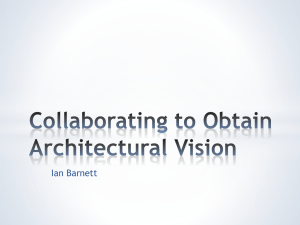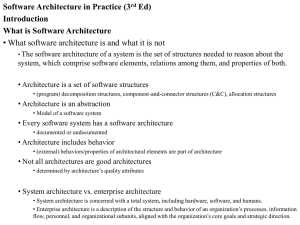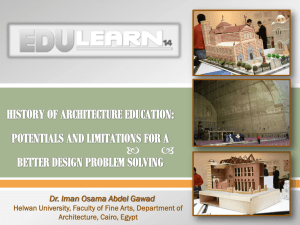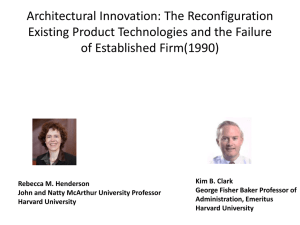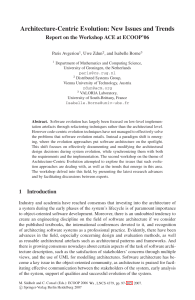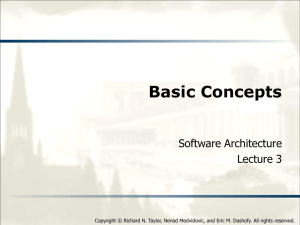The Big Idea - Electrical and Computer Engineering
advertisement
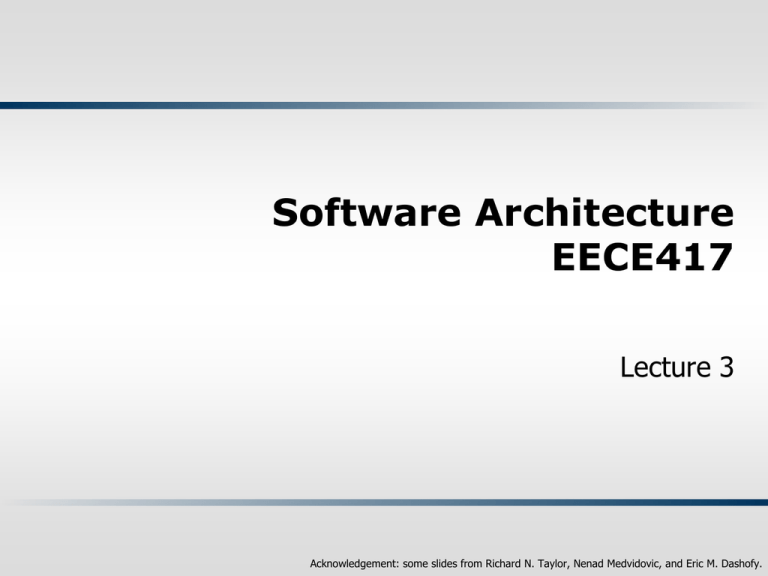
Software Architecture EECE417 Lecture 3 Acknowledgement: some slides from Richard N. Taylor, Nenad Medvidovic, and Eric M. Dashofy. Software Architecture Definition (source: Taylor et al., “Software Architecture: Foundations, Theory, and Practice) “[Software architecture is] the set of principal design decisions governing a system” “Principal” implies a degree of importance that grants a design decision “architectural status” • Implies that not all design decisions are architectural (i.e. they do notfacet necessarily Design decisions encompass every of the system under development impact a system’s architecture) Structure, Behavior, Interaction, Non-functional properties • How one defines “principal” will depend on what the stakeholders define as the system goals f Why is software architecture important? Communication with stakeholders Manifests early design decisions Transferable abstraction of a system Architecture is not a phase of development Treating architecture as a phase denies its foundational role in software development It is more than “high-level design” Architecture is also represented, e.g., by object code, source code, … 5 An ‘architecture-centric’ development process Requirements Design Implementation Analysis and Testing Evolution Development Process 6 Requirements Analysis Traditional SE suggests requirements analysis should remain unsullied by any consideration for a design However: Existing designs and architectures provide the solution vocabulary Our understanding of what works now, and how it works, affects our wants and perceived needs E;g: In building architecture we talk about specific rooms… …rather than the abstract concept “means for providing shelter” Insights from our experiences with existing systems helps us imagine what might work and enables us to assess development time and costs Requirements analysis and consideration of design must be pursued at the same time 7 The ‘Twin Peaks’ Model 8 Design and Architecture Design is an activity that pervades software development Typically in the traditional ‘Design Phase’ decisions concern creates part of a system’s architecture A system’s structure Identification of its primary components Their interconnections Architecture denotes the set of principal design decisions about a system That is more than just structure 9 Architecture-Centric Design Traditional design phase suggests translating the requirements into algorithms, so a programmer can implement them Architecture-centric design stakeholder issues decision about use of COTS component overarching style and structure package and primary class structure deployment issues 10 Design Techniques Basic conceptual tools Separation of concerns Abstraction Modularity Two illustrative widely adapted strategies Object-oriented design Domain-specific software architectures (DSSA) 11 Separation of concerns: Example (1) Layered architectures: e.g., Internet Separation of concerns: Example (2) Model View Controller design pattern Object-Oriented Design (OOD) Objects Main abstraction entity in OOD Encapsulations of state + functions for accessing and manipulating that state 14 Pros and Cons of OOD Pros UML modeling notation Design patterns Cons Provides only One level of encapsulation (the object) One notion of interface One type of explicit connector (procedure call) Even message passing is realized via procedure calls OO programming language might dictate important design decisions OOD genarally assumes a shared address space 15 Domain Specific Software Architectures Capturing and characterizing the best solutions and best practices from past projects within a domain Production of new applications can focus on the points of novel variation Reuse applicable parts of the architecture and implementation Examples product lines Recall the Philips example well understood domains 16 Implementation The objective is to create machineexecutable source code That code should be faithful to the architecture Alternatively, it may lead to change in the architecture Architecturally-relevant vs. -unimportant adaptations It must fully develop all outstanding details of the application 17 Faithful Implementation All of the structural elements found in the architecture are implemented in the source code Constraints Source code must not utilize major new computational elements that have no corresponding elements in the architecture Source code must not contain new connections between architectural elements that are not found in the architecture 18 Failure to recognize the distinction between planned and implemented architecture robs one of the ability to reason about the application’s architecture in the future misleads all stakeholders regarding what they believe they have as opposed to what they really have makes any development or evolution strategy that is based on the documented (but inaccurate) architecture doomed to failure 19 Implementation Strategies Generative techniques Frameworks CORBA, DCOM, RPC, … Reuse-based techniques collections of source code with identified places where the engineer must “fill in the blanks” Middleware e.g., parser generators COTS, open-source, in-house Writing all code manually 20 How It All Fits Together 21 Analysis and Testing Goals: Assess the qualities of an artifact Discover potential errors The earlier an error is detected and corrected the lower the aggregate cost Rigorous representations are required for analysis, so precise questions can be asked and answered 22 Analysis of Architectural Models Formal architectural model can be examined for internal consistency and correctness An analysis on a formal model can reveal Component mismatch Incomplete specifications Undesired communication patterns Deadlocks Security flaws It can be used for size and development time estimations 23 Analysis of Architectural Models (cont’d) Architectural model may be examined for consistency with requirements may be used in determining analysis and testing strategies for source code may be used to check if an implementation is faithful 24 Evolution and Maintenance All activities that chronologically follow the release of an application Software will evolve The traditional software engineering approach to maintenance is largely ad hoc Regardless of whether one is using an architecture-centric development process or not Risk of architectural decay and overall quality degradation Architecture-centric approach Sustained focus on an explicit, substantive, modifiable, faithful architectural model 25 Turbine – A Visualization Model Goals Provide an intuitive sense of Project activities at any given time The “information space” of the project Including concurrency of types of development activities Effective for indicating time, gaps, duration of activities Investment (cost) indicators Hard to present a multidimensional space! 26 5D! A Visualization Model Goals Provide an intuitive sense of Project activities at any given time Including concurrency of types of development activities The “information space” of the project Effective for indicating time, gaps, duration of activities Investment (cost) indicators Show centrality of the products (Hopefully) Growing body of artifacts Allow for the centrality of architecture 28 The Turbine Model “Core” of project artifacts time Testing Gap between rotors indicates no project activity for that t Radius of rotor indicates level of staffing at time t ti Simplistic Waterfall, Side perspective Coding Design Requirements 29 Cross-section at time ti Design (activity) Requirements Design doc 30 A Richer Example time Assess/… Test/Build/ Deploy Build/Design/ Requirements/Test Design/Build/ Requirements Requirements/Architecture assessment/Planning S1 31 A Sample Cross-Section 32 Software Architecture: Foundations, Theory, and Practice; Richard N. Taylor, Nenad Medvidovic, and Eric M. Dashofy; © 2008 John Wiley & Sons, Inc. Reprinted with permission. A Cross-Section at Project End 33 Software Architecture: Foundations, Theory, and Practice; Richard N. Taylor, Nenad Medvidovic, and Eric M. Dashofy; © 2008 John Wiley & Sons, Inc. Reprinted with permission. Volume Indicates Where Time was Spent Assess/… Test/Build/ Deploy Build/Design/ Requirements/Test Design/Build/ Requirements Requirements/ Architecture Assessment / Planning 34 A Technically Strong Product-Line Project Deployment Capture of new work Other Customization Parameterization Assessment 35 Software Architecture: Foundations, Theory, and Practice; Richard N. Taylor, Nenad Medvidovic, and Eric M. Dashofy; © 2008 John Wiley & Sons, Inc. Reprinted with permission. Visualization Summary It is illustrative, not prescriptive It is an aid to thinking about what’s going on in a project Can be automatically generated based on input of monitored project data Can be extended to illustrate development of the information space (artifacts) 36 Summary – architecture-oriented development process Software architecture affects every aspect of the classical software engineering activities The requirements activity is a co-equal partner with design activities The design activity is enriched by techniques that exploit knowledge gained in previous product developments The implementation activity is centered on creating a faithful implementation of the architecture Analysis and testing activities can be focused on and guided by the architecture Evolution activities revolve around the product’s architecture. An equal focus on process and product results from a proper understanding of the role of software architecture 37
